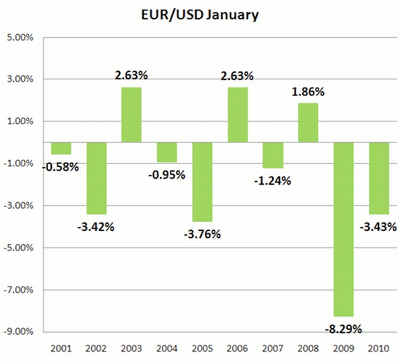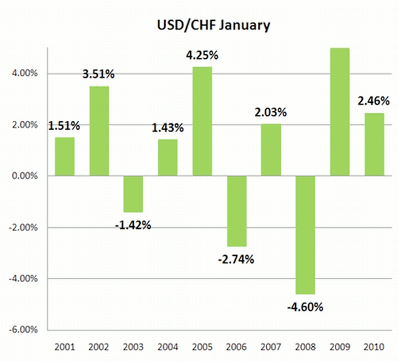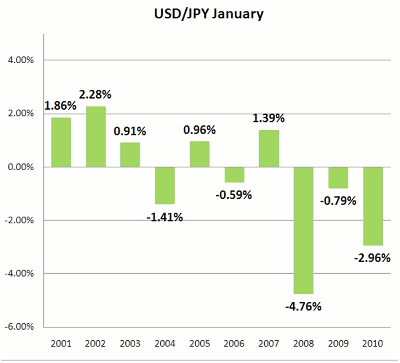As we turn the calendar to January 2011, we want to take this opportunity to talk about one of our favorite topics—seasonality trading in the currency markets.
There is an old saying in the stock market that the first five days of trading in January sets the tone for the rest of the year. Although this is not true for currencies, what we do know is that the dollar tends to appreciate in the month of January. The dollar treaded water throughout December following a very strong rally in November. This consolidation could turn into additional gains if seasonal factors have their way with the dollar in the New Year. Further dollar gains are not outside the realm of possibility given the challenges that lie ahead for the euro zone in 2011. The European sovereign debt crisis is an ongoing concern as investors remain worried about the possibility of fiscal troubles spilling over into the Iberian Peninsula.
The reason why we like to look at seasonality is because technical analysis is based on the idea that price patterns repeat themselves, and seasonality is rooted in this very same concept. Seasonality is defined as a pattern that occurs at given times within the calendar, and throughout the year, there are a good number of cases of seasonality.
The first set of charts illustrates the performance of the EUR/USD and USD/CHF in the month of January. In seven of the last ten years, both currencies lost value against the US dollar in January. In other words, during the first month of the year, the dollar strengthened against the euro and Swiss franc 70% of the time. The rally was particularly dramatic in 2009 as the credit crisis triggered massive deleveraging, driving investors toward the safety of the US dollar.
There are many reasons to explain this unique seasonality, the most obvious of which is beginning-of-the-year positioning. Typically, many foreign investors repatriate their money at year-end to dress up their balance sheets or prepare distributions. In the beginning of the year, they reinitiate their positions or initiate new ones, which can typically involve reweighing their investments in US equities and bonds.
For those who are curious, the seasonality bias in USD/JPY is not strong at all. Over the past ten years, USD/JPY rose five out of ten years and fell five out of ten. The GBP/USD, on the other hand, rose six out of the last ten years.
Seasonality does not work 100% of the time, which is why trading seasonality blindly by selling the EUR/USD at the beginning of the month and buying it back at the end of the month is not necessarily the best thing to do. The recent performance of USD/JPY is the perfect example. Therefore, the best way to incorporate seasonality into your forex trading is to simply be mindful of it. For example, it may be a better idea to look for opportunities to buy the dollar against currencies like the Swiss franc and euro next month than to sell it. What seasonality tells us is where the probabilities are skewed.
By Kathy Lien of GFTForex.com
























